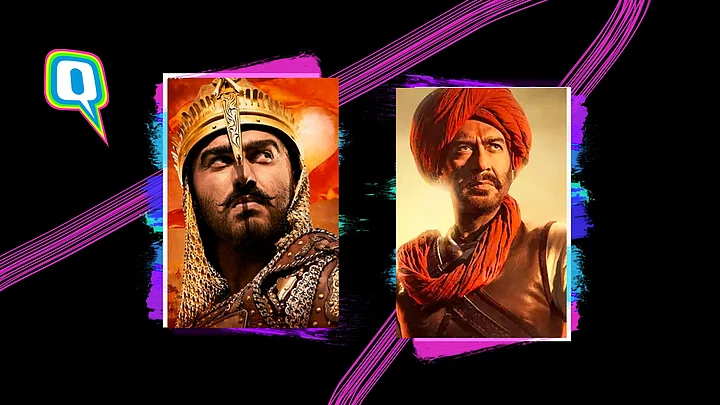What’s Bollywood craving for these days? Biopics, small town stories, and *drum roll* period drama. Speaking of period drama, have you seen the latest Tanhaji trailer?
Tanhaji, starring Saif Ali Khan, Ajay Devgn, and Kajol, is releasing on 10 January 2020. The movie, directed by Om Raut, is a period drama based on General Tanaji Malusare of Shivaji’s army to save Kondhana from the Mughal invasion.
But just 40 seconds into the trailer, I got a little confused as my mind started quizzing itself on my own limited knowledge of history and that’s when I noticed that the Tanhaji trailer looked weirdly similar to the Panipat trailer.
Now, Panipat starring Arjun Kapoor and Sanjay Dutt, set in the 18th century is the story of an Afghan King Ahmad Shah Abdali, who takes over the Maratha empire led by Sadashiv Rao Bhau. Panipat is directed by Ashutosh Gowariker, who last helmed the Hrithik Roshan-starrer Mohenjo Daro (2016).
Clearly, it’s taken Gowariker three years to make Panipat, and honestly, I see why!
Breathe, breathe...I am not that seventh-grade stickler who wants everyone to mug up the names and dates of historical events and know exactly which Battle of Panipat happened when, et cetera, et cetera.
But after seeing both the trailers, I couldn’t help but notice how formulaic they are. It seems like Bollywood has cracked the perfect recipe for period films. So let’s take a look at some uncompromising ingredients that go into making a period drama for the Indian audience.
1. The ‘Unsung’ Hero
He has been designated with the task of saving the empire. He keeps himself motivated and also pumps up the forces. Another thing which is a must is making tall promises not just about what he’s supposed to do, but also about his entire community.
Now, if you will see Arjun Kapoor or Ajay Devgn, both these characters are THE same. Cue, they are the ‘chosen ones’. Their mouths are filled with heavy dialogues, and every action of theirs is linked to their valour. And to spice it up, there’s even a dance number.
He is courageous, he is in command, he is a Maratha!
2. The Woman Who Needs a Saviour
Red is her favourite colour and she is feisty but insecure. She will do anything to defend what her husband is doing and also make snide remarks about how there’s a possibility that he’ll return with a ‘mastaani’. (Threatened by Deepika, are we?)
And don’t miss the most basic things she says with conviction to make it sound like some Plato-level philosophy.
Cue, Kriti Sanon in ‘Panipat’ trailer, “Maratha. Bharat bhumi ke woh yoddha jinke liye unka dharam aur karam unki veerta hai.”
3. The Kohl-Eyed Villain
I mean, here, styling does more than half the job. He’s a villain. He’s Muslim and what does he do? He wears kohl in his eyes and blood as his blush. Everything he says has to have a hidden meaning and when he enters the frame...everything goes dark. Because directors can’t imagine anything other than that to translate his persona on screen.
There has also been much discussion on how Sanjay Dutt’s character looks like Alauddin Khilji’s character from Sanjay Leela Bhansali’s Padmaavat.
4. That Lady Who Has Taken Some Random Pledge
You can even find her in Jodha Akbar. She’s just always there. And to my surprise, Suhasini Mulay has played *literally* the same role in every film. Talk about being consistent!
I am sorry but these women will only be seen once or maximum twice in the film: when our ‘unsung’ hero is going to wage a war against the enemy and he needs her blessing.
And that’s when she’ll drop it, the big bomb - WE WILL NOT WEAR SHOES or WE WILL NOT SLEEP TILL YOU ARE BACK or WE WILL NOT EAT POTATO.
And there you have it, my friends. These four character arcs are all you need to make a period drama in India.
(At The Quint, we question everything. Play an active role in shaping our journalism by becoming a member today.)
